► New Focus ST takes on rivals
► Rowdy i30N and fast GTI TCR
► Which one comes out on top?
Stop! Thief! The old hot hatch order was rocked when Hyundai’s i30 N snatched hot hatch glory. Can the new Ford Focus ST and final-fling VW Golf GTI TCR catch up?
Keep scrolling for our comparison test of the three potent hot hatches.
Ford Focus ST: pre-flight briefing
Why is it here?
It’s all-new, takes a lot of inspiration from its fantastic Fiesta ST sibling and is keen to throw a punch Hyundai’s way. Plus, the standard Focus is a Giant Test winner, so the ST comes from good stock.
Any clever stuff?
Previous-gen Focus RS 2.3-litre heart with anti-lag turbo tech, an e-diff, drive modes and adaptive dampers for the first time on a Focus ST. Performance Pack adds lairy Track mode, launch control and rev matching to smooth your downshifts.
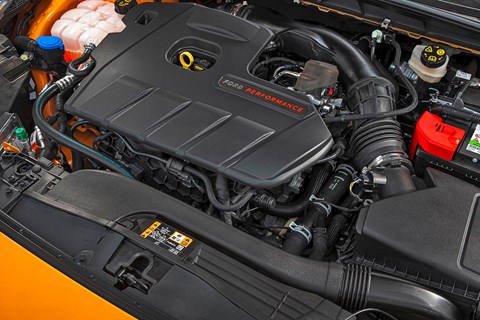
Which version is this?
Five-door manual hatch with a flat (but well-equipped) specification that you add options to, instead of the Fiesta’s ST-1, 2 and 3 grades. Estate and auto versions also available, as is a 187bhp diesel version for high-flying fleet drivers.
Check out our Focus ST review
VW Golf GTI TCR: pre-flight briefing
Why is it here?
It wouldn’t really be a front-drive hot-hatch test without a GTI, would it? VW has injected some racing-car steroids into the TCR, producing a model that’s the Mk7.5 Golf GTI’s last shot at glory before it’s replaced in 2020.
Any clever stuff?
Mechanical limited-slip differential is standard (the others have electronic diffs) and drilled brake discs. TCR Performance Pack de-restricts top speed, lowers the ride by another 20mm and adds adaptive dampers. At this price, you’d assume they were fitted as standard.
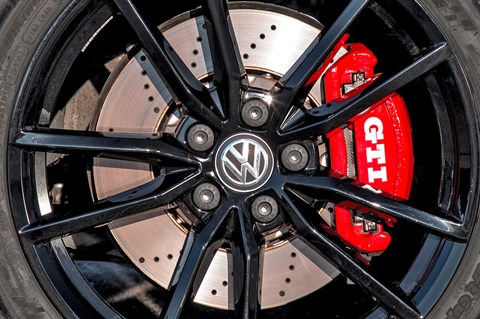
Which version is this?
It’s the auto-only TCR – the newest, most hardcore GTI. A 45bhp power increase over the GTI PP makes it the most powerful and quickest-sprinting here. TCR models have a more aggressive bodykit, stainless-steel exhaust and optional honeycomb-shaped acne across the doors.
Check out our Golf GTI TCR review
Hyundai i30N Performance: pre-flight briefing
Why is it here?
Grabbed everyone’s attention from the off by being a fantastic hot hatch from an unlikely source. Became much-loved among the CAR team for its value, its Albert Biermann-fettled handling and the fact it has a silly side – a hard-to-define quality that’s an important part of any hot hatch.
Any clever stuff?
Everything you need is included straight out of the box, which isn’t the case with the other two. This N Performance version has e-diff with torque vectoring, launch control and active exhaust. Revcounter and shift lights ape BMW and Ferrari respectively, and add a bit of touring car theatre.
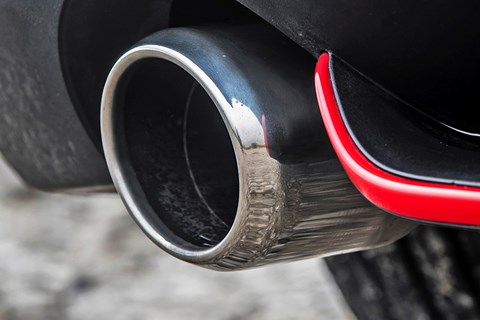
Which version is this?
The N Performance hatch, by far the best seller. Lesser-equipped and mostly-ignored 248bhp model also available, as is a swoopy four-door Fastback. Lighter, more hardcore Project C variant strips weight by using carbon, and ups the price.
We lived with an i30N – check out the full report
Ford Focus ST: bland to behold, a blaST to drive
Go on, admit it: if this Ford Focus wasn’t painted in Orange Fury you wouldn’t confidently say it was the new ST at first glance. An ST-Line, maybe, but a full-on hot hatch? Surely not. And yet that’s exactly what this is. And its modest identity crisis is indicative of the very fine balance Ford has to strike with the ST.
In the ever-shifting, ever-improving, keenly-contested world of the hot hatch, the ST has a lot of jobs to do. It needs to be bang on the pace when compared to other £30k-ish, 275bhp-ish hatches, but it must also, in the absence of a more hardcore Focus RS, offer something to appeal to those tempted by the more powerful likes of the Civic Type R.
It has a lot to prove: when we put the previous model in our August 2014 mega test marking 50 years of hot hatches, it emerged near the bottom of the pack with only a three-star verdict. More recently, it’s also been overshadowed by one of the biggest hot-hatch surprises in recent history: the Hyundai i30 N. Even the fortress of stability that is the Golf GTI felt the shockwave from this Korean invasion – so much so that VW has mounted a honeycomb-addled, racecar-inspired counter-offensive with the new Golf GTI TCR. We’ve brought both the Hyundai and the Volkswagen along to test against the new hot Ford.
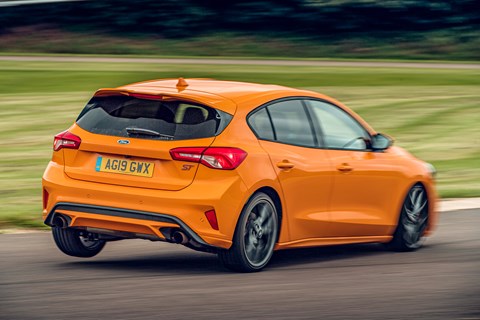
The Focus has the right stance, but it just looks too subtle next to the Hyundai and VW. Take away the curdling-custard paint and your only substantial visual cues are a double-pointed spoiler, red brake calipers and metal-tipped twin exhausts. The ST badges are easily missed.
Same story inside, too. The Focus is as gloomy to sit in as a doomsday bunker but, ergonomically, it’s absolutely bang on. Clear instruments, chunky steering wheel, a highly adjustable driving position that allows you to sit usefully low, ventilation controls that don’t induce befuddlement and Ford’s Sync 3 infotainment system that, while simple in design, works well, with its crisp graphics and high-mounted screen. But there’s little to differentiate it from a well-specified ST-Line, bar tremendously supportive and adjustable Recaro seats, and the drive mode and separate ‘S’ (for Sport mode) buttons on the steering wheel. The previous model had no drive modes, but the new one gets three as standard – Slippery, Normal and Sport – with lairy Track mode bundled with the optional (and inexpensive at £250) Performance Pack.
The best hot hatches you can buy right now
Not the greatest start, then, when parked next to its Giant Test rivals. Who’d have thought that, colour aside, a performance Golf and a Hyundai would look more aggressive than the traditionally yobbish Ford? If first impressions are important, this is a missed opportunity.
Out on the road, though, those gripes fall by the wayside. Starting the ST brings back memories of the previous-generation Focus RS. But then it would, as the 2.3-litre EcoBoost turbocharged four-cylinder used here is a detuned version of the engine found in the old all-wheel drive hooligan. In this car it’s tuned for 276bhp, which isn’t exactly paltry, and the 5.7sec 0-62mph time leaves the Hyundai for dust (6.1sec) and keeps it almost level with the Golf (5.6sec) on paper.
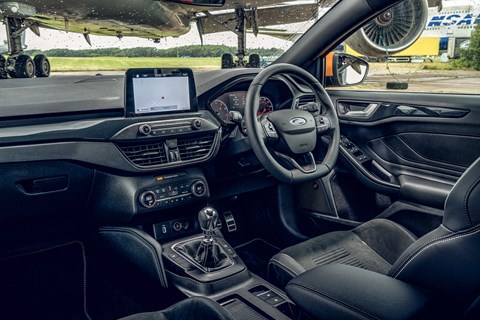
The figures show the ST has faster in-gear acceleration than the old RS (thank reduced weight and shorter ratios), and you can feel that when you fully commit. It helps that the response of that pedal is sharp even if you’re in Normal mode, but pleasingly the engine is also more flexible than those of its rivals, pulling happily from low revs in sixth gear.
As for the noise, it emits pops and bangs in Sport between gearchanges to insert a fat smile on your face, even if it’s not the full assault-rifle experience served up by the old RS. Inside, the noise is digitally enhanced in Normal and Sport and, while it’s not entirely convincing, it sounds far less like you’re playing Gran Turismo 2 than the sound effects of a Renault Megane RS or Peugeot 308 GTi.
You can revel in the Ford’s early-biting, neatly-weighted clutch, and a manual gearshift that’s happily devoid of the unnecessary resistance offered by, for example, the Megane RS. Ford’s Performance Pack also throws in rev matching to automatically blip the throttle on downshifts which, for the eager but inexperienced, is handy for keeping things smooth. You can’t turn the rev matching off, though.
The steering ratio is 15 per cent faster than a standard Focus, and this hatchback variant (but not the estate) has adaptive dampers (Ford’s Continuously Controlled Damping) as standard. The crown jewel in this configuration is an electronically controlled diff, which helps stop the Focus ST descending into a torque-steery mess like its predecessor.
It all helps make the Focus by far the most agile car on test. The steering rack, while faster than a Fiesta ST’s, doesn’t feel nervous off-centre. It’s so speedy you can keep your hands at quarter-to-three, even exiting 90º T-junctions. On track, that makes the ST hugely adjustable mid-corner, with the most eager front end of our test cars; the e-diff is the least intrusive of the three, gently trimming your line and building confidence. On the road, you soon find yourself feeding in power through a corner where normally you’d be considering stamping at the brakes in a panic.
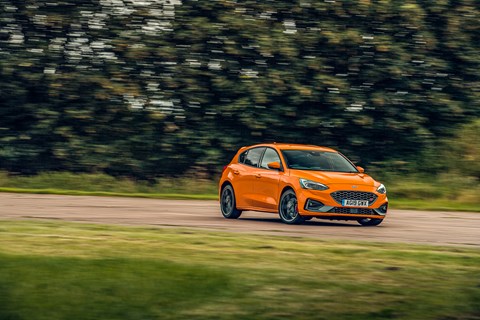
And these really are some brakes – with more stopping power than those on the RS. Even after a day’s blasting around a track and some twisty B-roads, there was no sign of fade or fatigue from the 330mm front/302mm rear discs, with a crispness to the brake pedal neither rival could match.
Those adaptive dampers are impressive, too, but the Focus still claims the dubious honour of being the firmest car here in its most relaxed damper setting. The ride in everyday situations is generally bearable, but it’s incredibly jiggly through a pothole-riddled village. Sport and then Track increase that stiffness, but the extra poise pays dividends when you’re working to maximise the ST’s performance – this is ultimately the more satisfying drive than either the Hyundai or VW. It’s a shame there’s no custom or individual mode allowing you to tailor your preferences.
Initial disappointment about the demure exterior design and plain interior soon feels irrelevant. When a car is this enjoyable to drive, a lack of visual sharpness really doesn’t seem that big a deal. And that driving enjoyment applies on track as well as on a good road; get out of town and the all-round talent of the sublime Ford surpasses the VW. There’s a glorious precision to all the controls that the other two can’t match, meaning that on every journey you feel connected to the ST and eager to explore its considerable potential, again and again.
VW Golf GTI TCR: least sensible GTI is still sensible
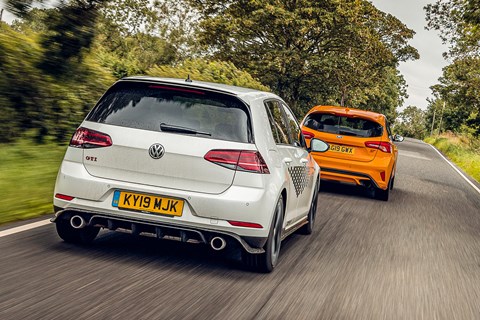
There’s no point in a quiet last hurrah. It makes sense, then, that the last edition of the Mk7.5 Golf GTI is significantly different from any other Golf, and draws visually on VW’s touring car racers.
The changes between this and a Golf GTI with the Performance Pack are pretty stark. Most importantly, the 2.0-litre turbo is boosted by 45bhp over the PP, taking the peak output to 286bhp, and there’s a mechanical limited-slip diff and drilled brake discs as standard too. There’s no choice of gearbox: you get a seven-speed DSG, which Volkswagen is keen to point out is the same transmission used in its racing Golf. Tenuous link alert! It’s also why this GTI’s bodykit is much more elaborate, with a gloss black front splitter and sledge-sized rear spoiler. The honeycomb door decals are, you may well be pleased to learn, optional.
You know at a glance it’s a Golf, and there’s near-universal agreement that the Golf species still looks good; remarkable, really, that VW can make a car that’s as ubiquitous as red traffic lights yet still appealing.
The familiar Mk7.5 GTI interior here sits underneath several layers of polish, like your nan’s immaculate mahogany sideboard. It’s the classiest car of this trio, despite its age. While the Discover Pro navigation system is starting to look dated, the high-gloss trim, digital instrument display and perforated leather steering wheel all add a premium feel. The seats are the stand-out feature, though, injecting some much-needed colour into a sea of gloss black, with the traditional GTI tartan replaced by a geometric pattern bespoke to TCR cars. It’s a shame they perch you as high as a tennis umpire, though.
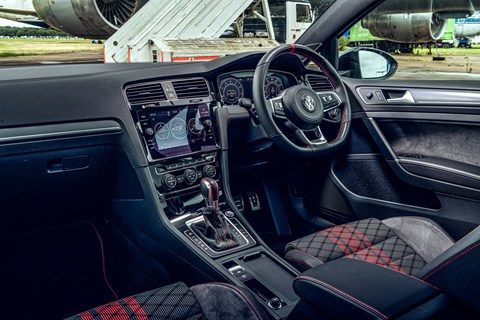
Around town, the Golf has the most supple chassis on test. Even upgraded from 18- to 19-inch optional alloys, the Dynamic Chassis Control (which isn’t standard, despite the TCR’s £35k price) has a Comfort mode that means what it says. Daily-driving a TCR is in all important regards just like driving any other auto Golf; if it weren’t for the lewd decals and fat, shiny metal tailpipes, plenty of passengers and pedestrians might be none the wiser after a gentle commute.
The mechanical differential hinders the turning circle, which makes parking a little more cumbersome, but otherwise the Golf is understated, entirely usable and, when just pottering about, perfectly civilised.
Perhaps a little too civilised for its own good. Put your foot down and the GTI accelerates with the low-key efficiency of a sniper. There’s a flat surge of power that never peaks or troughs – it just gets on and does its job, with an unintrusive raspy growl from the turbocharged four-cylinder engine, occasionally accompanied by a single exhaust pop.
The performance is quite an achievement, but the seven-speed DSG transmission stops you getting particularly involved in the experience. In town or on the motorway it’s an undoubted boon to be able to leave the car to shift for itself. But when you’re keen to engage fully with the driving experience, the GTI doesn’t want to go all the way. The light clack from the wheel-mounted paddles and consequent push back into your seat is about as much involvement as you’ll get here, which feels a little… off. Driving the Golf back-to-back with its two manual rivals makes me yearn for the Volkswagen’s golfball stick shift.
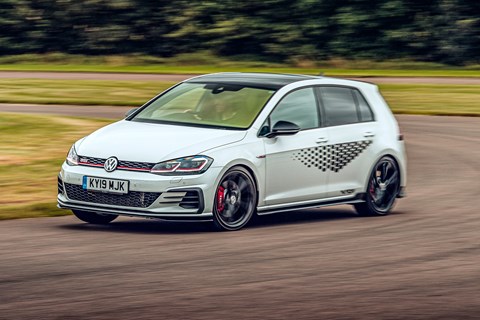
It’s a similar case when it comes to the handling. When the going gets twisty, the Golf is pliant and stable but it’s lacking that final bit of finesse to make it a properly brilliant driver’s car. There’s a looseness to the steering that the Focus simply doesn’t have and that the Hyundai does a better job of curtailing.
There’s also a general bias towards understeer if you get over-zealous with corner entry speeds. There’s less of a pivoting action at the centre of the car here than in the others, the Focus in particular. Instead, the Volkswagen just deals with whatever road surface or corner it’s presented with, neither complaining nor getting particularly enthusiastic. That’s a long way from the classic – often quite ragged – hot-hatch experience.
The best hot hatches you can buy right now
The Golf is definitely more road car than track car, which is a little ironic given VW is playing on its international touring-car campaign with the GTI TCR’s badging, visuals and marketing. Compared with the eager and light-footed Focus and the adjustability of the Hyundai, the Golf feels inert and heavy on track.
It’s properly quick yet feels safe and solid to drive quickly, without offering the glorious combination of feedback, engagement and zing that defines the other two.
Hyundai i30N: feisty, fun… but not very frugal
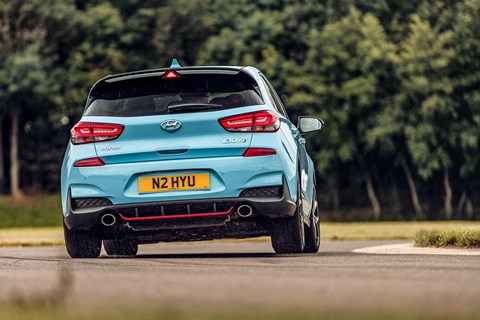
There was quite the buzz when Hyundai’s i30 N hot hatch was first announced, with R&D boss Albert Biermann putting years of experience at BMW M into an all-new product for a manufacturer that’d only previously dabbled in the segment with the Veloster Turbo.
The i30 N certainly delivered when we first drove it in 2017. It looked like a hot hatch, sounded like a hot hatch, drove as well as the most accomplished on the market and was competitively priced.
Nothing has changed since then (though a slightly softer suspension set-up will be rolled out soon, in line with i30 N Fastback models), but the Hyundai i30 N had to be in this test, simply because it toppled the previous Focus ST as a hooliganist pocket rocket and made the increasingly senior Golf GTI seem way too sombre. Can it continue to impress against the new Focus ST and the feistier Golf GTI TCR?
As standard, you get a 2.0-litre turbo engine that sends 248bhp to the front wheels, for £25,995. But most buyers upgrade to the N Performance model we’re testing. For £29,495, it ups the ante to 271bhp, and includes 19-inch alloys, an electronically controlled limited-slip differential, uprated brakes, active exhaust, and faux suede and leather seats.
Even after a couple of years, the N’s looks haven’t gone stale; red trimmings on the front and rear splitters, a gaping front grille, two bazooka-sized exhaust pipes and details like a rear wing with a triangular third brake light do just enough to hint at the potential without going over the top.
Inside, it’s much like the Focus, in that it’s dominated by textured grey plastic. But it’s also incredibly user-friendly and neatly laid out, with an equipment list that if anything is marginally better than the Ford’s: cruise control, heated steering wheel, parking sensors and rear camera, keyless entry and go, sat-nav and wireless charging… The N’s seats provide the best thigh support, too – great for taller drivers.
Light blue winged paddles inset on the steering wheel open up a world of drive mode configurations. N mode is for maximum attack – everything becomes either heavy, loud, firm or devoid of electrical helping hands – but you can adjust it via ‘N Custom’, so long as you have 10 minutes spare to sift through the configuration menu. Rev matching for the manual gearbox is toggled via a simple ‘Rev’ button on the wheel, accessible even in the i30’s more docile drive modes. Unlike the Ford’s rev matching, the Hyundai’s can be fully deactivated.
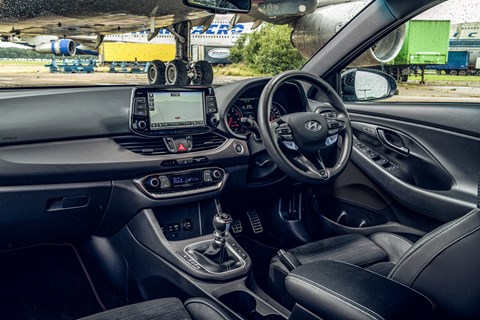
As the quoted 6.1-second 0-62mph time suggests, the i30 N’s acceleration is slightly tardier than the Ford’s and VW’s, but this never feels like a slow car. Its fantastic noise helps. If the Focus makes you grin, try selecting Sport+ on the Hyundai’s exhaust: the Gatling gun impression from its active exhaust is downright hilarious.
The i30 N is a workout to drive aggressively, but on the right road it’s such a rewarding car. The steering is heavy even in its most relaxed setting, and requires more muscle the further up the drive mode tree you climb. At its heaviest, it feels leaden compared with the Focus, sapping away any precise edges to your steering inputs. Still, the Hyundai is more adjustable than the VW on track and can be eased into oversteer if provoked mid-pivot, just like the Ford.
A similar amount of hard graft is involved with the pedals and gearshift. The clutch is supremely well weighted for driving like your hair’s on fire, if a touch too heavy for long traffic-jam crawls. Sharper throttle response would also be welcome. The gearshift has a heavy-duty action and some of our road testers complained about its notchiness. The Focus certainly has the sweeter shift, but the i30 N’s gritty edge has a mechanical, sporty appeal.
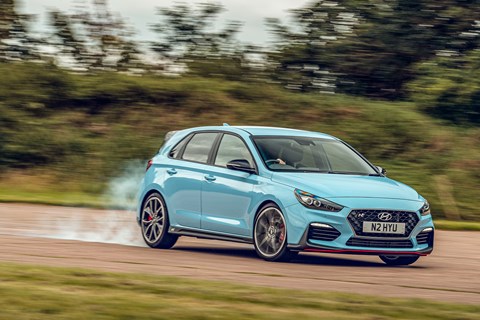
After all, involvement is the Hyundai’s main draw. It’s full-on and in-your-face, and if you’re in the mood it’s very keen to give you a good time. You’ll pay the price for fully exploiting the performance, though. Despite its 50-litre tank being just two litres smaller than those of its rivals, the Hyundai needed filling far more frequently than the others.
Despite that, the purchase price ensures the Hyundai can play the value card. There are no options to add to the i30 N Performance other than the colours, some of which will just edge it over the £30,000 mark – our car’s Performance Blue paint pushes it to £30,080. That’s still £2000 cheaper than the Focus and will, for some, be two thousand reasons to go for the Korean contender.
Focus ST vs i30N vs GTI TCR: have cake, proceed to eat it
It’s amazing how three front-wheel-drive hot hatches can feel so different from each other, while all being highly impressive. Any VW Golf still remains an attractive choice, even after 40 years and more than 2.3 million sales. The solid, classy competence of the regular models is joined by a healthy dose of thrills when you step up to a GTI – even more so in the case of the TCR. But the great progress made by VW’s many rivals and imitators is clearly evident here. The TCR is very good family transport and a hugely competent performance car, able to switch between the two roles in the blink of an eye, but ultimately it loses out to both the Focus and the i30 in terms of driver engagement.
It’s very close. The VW’s speed and handling would be regarded as superb by most standards, but here it’s outshone as a hot hatch by the Ford and the Hyundai. They both deliver on the same brief with a little more dynamic finesse and fun.
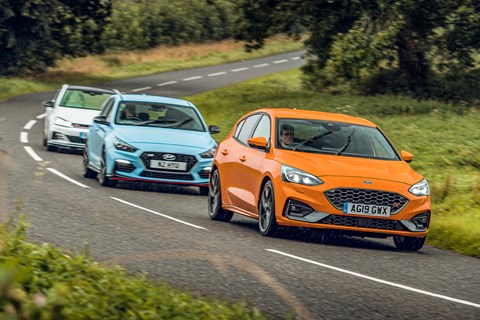
We’ve liked the i30 N from the off, and it remains a great deal of fun at a very good price. Few hot hatches get the basics so right on a gut level. The Hyundai is loud and proud, likes to be treated roughly and gives as good as it gets. It also has quite a thirst. For some tastes, it’s all a bit much.
That’s what makes the Focus ST the best balance between logic and emotion. It’s not cheap any more, and we’d like it to look a little more exciting. But it’s by far the best car to drive here: eager, adjustable, punchy, precise, and more than capable of hanging its back end out. It can make loud noises and get lairy on request, and you can have it painted in the same colour as a Love Island contestant. But it’s still a Focus, and this generation in particular is very good family transport.
The ST has grown up from its warbling five-cylinder childhood and gone through torque-steery puberty to emerge a mature hot hatch that can be as rewarding on a track and a B-road as it is well suited to family life. It’s got a decent boot, good rear legroom and driving position, and it’s easy to manoeuvre. With 276bhp and infallible front grip, it’s the winner.
Buy the Golf GTI with your head and you’ll have a sound, speedy package. Buy the Hyundai with your heart and you’ll have a great driver’s car. Buy the Focus ST and you can have both.
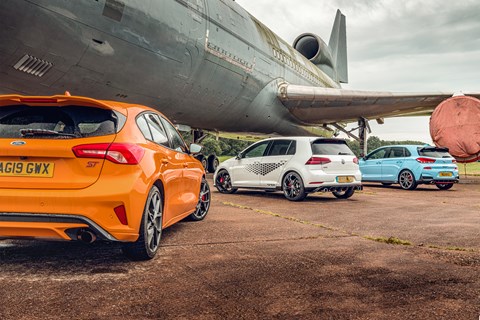
Focus ST vs i30N vs GTI TCR: verdict
First place: Ford Focus ST
The best car to drive, and strikes the best balance between fun and family. No longer cheap, though.
Second place: Hyundai i30N
Bargain hooligan is still thoroughly entertaining, but the new Focus ST is easier to live with.
Third place: VW Golf GTI TCR
Still got it, but too sensible to stir the soul, despite being the quickest and most powerful car here.
Check out more CAR comparison tests here